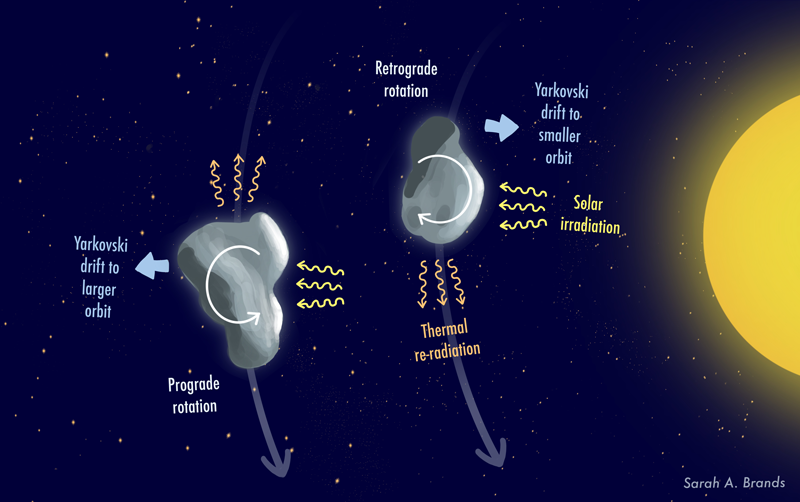The primary objective of the European Space Agency’s (ESA) Gaia satellite is to observe more than a billion stars to create the most accurate and complete map of the Milky Way. The mission recently released a collection of data with details on more than 1.8 billion stars and several million galaxies and quasars.
Gaia’s new release also contains precise positions and velocities of more than 150,000 asteroids in our solar system, a significant fraction of the 1.2 million asteroids we know of today. The satellite also measured spectra of reflected solar light for about 60,000 asteroids, a factor of 10 more than what was previously available. The rich data set is allowing scientists to dig deeper into the solar system’s history.
Tracking Asteroids
Asteroids hold a key to the history of the solar system.
Asteroids hold a key to the history of the solar system. Their orbits and compositions tell a story about planet migrations, chaotic orbit evolutions, and past collisions. Accurate orbit calculations enable scientists to match asteroids with meteorites that fell to Earth, whose compositions can be measured in detail in a lab. Some categories of asteroids known as “primitive” have even preserved the composition of the protoplanetary disk from which our solar system’s planets and other celestial bodies formed.
To understand the solar system, it is therefore essential to take stock of the rocky jumble by searching for new asteroids and keeping track of the old ones.
All but a tiny fraction of the asteroids in the new Gaia data release are old acquaintances. “Gaia is not a powerful machine for discovering asteroids, but it is very powerful for their characterization,” said Paolo Tanga, a planetary scientist at Observatoire de la Côte d’Azur in France who led a study on the asteroid survey.
Gaia measures asteroids’ orbital positions and 3D velocities as well as brightness. It also measures reflectance spectra for the brighter objects, which will help provide insight into asteroids’ shape and rotation.
On average, Gaia measures asteroid positions and trajectories about a thousand times more accurately than what was available before, allowing researchers to calculate more precise orbits. Such precision allows scientists to detect binary asteroids in the main belt by searching for tiny, periodic oscillations in their positions.
Tracking binary asteroids is important because certain pairs enable the measurement of asteroid densities. “Bulk densities are well known for 30 or 40 asteroids, and for the rest, we only have an indirect estimate,” said Tanga.
Yarkovsky Effect
Scientists have said Gaia might play an important role in characterizing the Yarkovsky effect, a complex force governing asteroid dynamics. The effect (sometimes called the Yarkovsky drift) accounts for how solar radiation and an object’s rotation influence an asteroid’s orbit.
“The Yarkovsky effect is rather complicated because it depends on a lot of different physical parameters,” said Sarah Greenstreet, a planetary scientist at the University of Washington. One of the key parameters is an asteroid’s size.
The effect has been measured for 234 near-Earth asteroids—but not a single main-belt member. Gaia might be able to measure the Yarkovsky effect for main-belt asteroids with sizes between 2 and 5 kilometers. “Gaia can help us better understand how asteroids move around the solar system and how things can move from the main asteroid belt into orbits that put them closer to the Earth,” said Greenstreet.

The Yarkovsky effect is also responsible for the dispersion of asteroid families, or collections of asteroids with similar orbital elements that are thought to be fragments of past asteroid collisions. Accurate orbit calculations and reflectance spectra will help researchers identify far-flung family members and how their current orbits evolved.
Time to Do Some Science
The search for binary asteroids and measurement of the Yarkovsky effect are just two of many possible projects awaiting scientists using Gaia data. Tanga is also excited about using precise positions and velocities to predict when asteroids pass in front of stars. He said observations of such occultations, carried out by professionals and through crowdsourced science alike, are priceless because they lead to much improved measurements of asteroids’ shapes and sizes.
Gaia’s next catalog, to be released in a few years, will likely double the number of asteroids studied, will contain more information on their shape and rotational properties, and will likely also include data about comets.
—Jure Japelj (@JureJapelj), Science Writer


